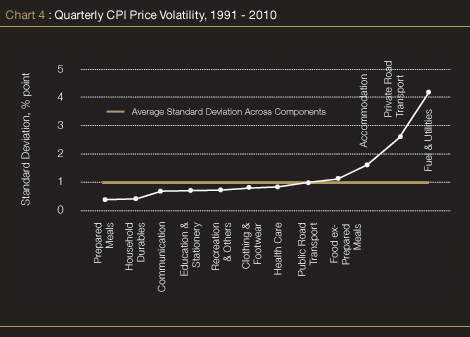
| MONETARY POLICY | 22 | |
| Box 1: The MAS Core Inflation Measure for Singapore | 24 | |

The MAS Core Inflation Measure for Singapore
For the past two decades, MAS has monitored a core inflation series to provide another perspective on price developments in the economy. Such a core inflation measure should have the following two characteristics. First, it should reflect persistent rather than temporary price changes. This is particularly relevant for monetary policy, which affects inflation with long and variable lags and is, therefore, not meant to address short-term fluctuations in prices. Second, core inflation should capture generalised price movements and ignore changes due to sector-specific influences or non-market factors, such as government price controls. Hence, by capturing the underlying price trends in the economy, core inflation serves as a useful input for monetary policy formulation.
Most countries exclude the costs of food and energy products from their core inflation measure as these are deemed to be volatile and largely determined by supply disturbances or changes in administrative policies. In Singapore's case, food and energy items are included in the measurement of core inflation, as they not only have a substantial weight in the CPI basket (27%), but their prices are also directly influenced by our exchange rate-centred monetary policy. Instead, MAS Core Inflation is calculated as the CPI less the costs of accommodation and private road transport. These items are excluded because they tend to be volatile and are strongly influenced by administrative policies.
In particular, accommodation costs are subject to the influence of government rebates on HDB rentals and Service & Conservancy Charges, while private road transport costs are largely driven by the government's motor vehicle policy, notably the Vehicle Quota System. Thus, the disbursement of HDB rebates in certain months of the year and changes in motor vehicle policy have made the costs of accommodation and private road transport extremely volatile. (Chart 4)
The MAS Core Inflation measure has served its purpose well, being less volatile than headline CPI inflation but nonetheless tracking it closely over time. (Chart 5) It is also a good indicator of underlying trend inflation, one of the most important attributes expected of a robust core inflation measure.


